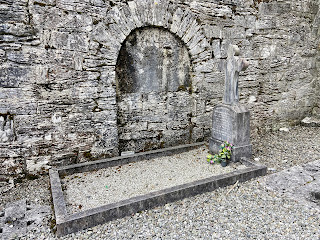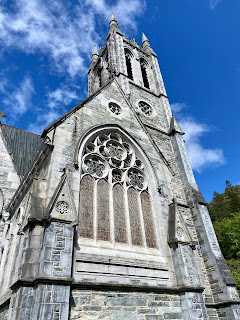After traveling south, today's bus heads north, first to Cong (County Mayo, pop 145 in 2016), famous as the filming location for The Quiet Man. Even seventy years later, there is a small museum and a statue honoring the movie. The Oscar-winning film explores issues of masculinity and femininity, such as they were, so maybe our current equivalent is Barbie.
Past the statue of John Wayne and Maureen O'Hara is Cong Abbey (twelfth and thirteenth centuries), a beautiful, ruined church, cloisters, and cemetery. There is just enough left to understand the layout of each building, the details hover between Romanesque and Gothic. The grounds are immaculate, and some of the walls are behind scaffolding, clearly under restoration.
The Abbey is enchanting, but our time is limited. Our guide recommends the purchase of a sandwich at a local bodega before we head off to Kylemore, and we dutifully comply.
The bus makes stops at the east and west ends of Lough Nafooey – the lake is lovely, but we suspect this is more of a leg-stretching exercise. Still, if we want to experience Connemara and the 'wild Atlantic way', these misty vistas are perfect.
It's lunchtime when we reach Kylemore Abbey (nineteenth and twentieth centuries). Again, as per our guide, we take the shuttle to the Victorian Walled Garden (nineteenth century), where we find tables and eat our sandwiches.
The Garden is an excellent counterpoint to the Cong's cemetery, full of life and enclosed by the sparkling peaks of Connemara National Park. The Garden sits in an east-west valley, which likely aids irrigation. A high, stepped wall follows the valley to the main gate at the Garden's eastern end, then back up the other side.
Rather than the typical symmetrical borders, this Formal Flower Garden features random diamonds, swirls, and circular shapes cut into a lawn – almost Seussian.
Several garden structures inhabit the upper northern side: the Glasshouses, a bothy and toolshed, the Head Gardener's House, and a standing brick wall with a door (which appears to be a building under reconstruction).
Crossing a stream, we see the western half is devoted to the Kitchen Garden, with beds for vegetables, herbs, and cut flowers. This seems all laid out for easy cultivation, but it is spectacular.
Before leaving, we peer into the hillside for the Sacred Heart Statue (a small 'Christ Redeemer') which is halfway up the hill; we can just make it out above the western tower.
The Neo-Gothic Church (nineteenth century) is a memorial to the original owner's wife, Margaret Vaughan Henry, who died tragically while traveling in Egypt. It is stunningly picturesque with the tall hills as backdrop.
From the exterior we understand how this is 'Neo'. The gargoyles, for example, don't 'gargle', rather they are scuppers for downspouts. And in this case, they are angles as opposed to grotesques. Each angel holds a unique object, a book, a sash, a shield, so perhaps these are female saints.
The tourist information describes this as a "miniature cathedral". From the western approach, that sounds plausible: three bays to a crossing, a short south transept, and the bell tower. The entry portal interrupts the western-most bay and looks across to a level burial yard.
On the north side, we realize there is no transept, though the entry and 'crossing' bays are distinguished by the three trefoils in each roundel. The stonework is fabulous, especially the quoining and the corner buttresses.
A group of goats, however, is unimpressed.
The amazing stonework continues inside. The vault ribs land on contrasting dark, bundled pilasters.
The numerology in the window fenestration is fascinating. The rose in the altar window has eight trefoils around a five-petal rosette, reducing to four petals in the glass. The three paired lancets are topped with five-petal roundels and a quatrefoil in the middle. There are three aedicula over the entry with birds in the roundels and angles on the finials. Across the back, there are five aedicula all dressed in vegetal motifs.
The south 'transept' appears to be a memorial chapel (perhaps for Margaret). The glorious stained-glass panel suggests that the gargoyle-angels are not saints but 'virtues'. Five are shown here: Fortitude (with sword and shield), Faith (with cross and book), Charity (with children), Hope (with anchor), and Chastity (with veil).
Centered above these five is the Sacred Heart, and on each side a pair of angels holds banners that read, "Glory to God … In the highest". Above this is a six-petal rosette with musicians (trumpet, violin, harp, lute), and in the center cinquefoil the featured soloist plays an accordion (horizontal keys and vertical bellows).
Returning to the Castle, we have time for a quick tour of the main rooms. The first few rooms showcase the Benedictine nuns. The Old Library tells the history of the Castle and Abbey (old photos below), with ghostly projections of Mitchell and Margaret reflected in the mirrors. The Front Hall is a kind of 'family portrait in walking sticks'; by the door is Saint Benedict with his own stick.
The Drawing Room is at the eastern corner, and features Margaret's pink ball gown (Barbie again?). The 'birds and flowers' theme is repeated in the marble fireplace surround. The Morning Room (facing east) leads to the Dining Room.
Upstairs there are private rooms but also a kind of auditorium space. Back downstairs, the Gallery Hall is dominated by the trophy head of a deer. Looking up as we exit, there is one more angel holding the family crest, with a lion and a rose.










































































































No comments:
Post a Comment